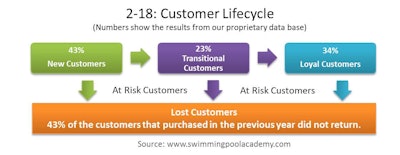This post is the final installment in my series covering some of our research on customer retention and win-back. I hope you enjoyed it. You can access all 18 posts by clicking my contributor page or send me an email to the address at the bottom of this page and I'll send you a PDF file of all the articles. Since many of you are getting ready for the current pool season, I've summarized 12 key points below to help pull everything together.
1. Exposing the myth of customer satisfaction
Even extremely satisfied customers may not be loyal, while many loyal customers are not sufficiently satisfied. Despite the fact that customer satisfaction is important, it is merely a means to an end. The real goal is customer loyalty, and that is measured in terms of customer retention. To be successful long term, retailers must create repeat customers that continue to buy from them each and every year. Yet very few swimming pool retailers sufficiently understand customer retention, let alone measure, track and improve it.
2. Industry retention rate benchmark
Using our proprietary point-of-sale database, we calculated the average annual retention rate for our sample of 88,000 retail consumers. On average, pool retailers retain 57 percent of the customers that bought from them in the prior year. That means they lose 43 percent each and every year! This is a huge potential profit drain that cannot be counteracted by simply recruiting new customers as replacements. It is imperative to make sure it is not overlooked. Most companies in our industry are not aware of the loss associated with customer defection and the substantial profit that can be recovered by winning back some of these lost customers.
3. Using your point-of-sale (POS) data
The vast majority of pool and spa retailers are capturing a wealth of information through their point-of-sale systems, yet most are doing very little with it. For example, they don’t know which customers are at risk, which customers have defected, how to address these problems with more relevant targeted efforts and what is or is not working. The bottom line is this: Customers are communicating with you through your POS data, so customer retention involves learning how to listen and generate a relevant response. It's your data, so use it!
"Customer lifecycle" is a term used to describe the progression a customer goes through when considering, purchasing, using and maintaining loyalty to a product or service. There is risk of customer loss or defection at each stage. Identifying at-risk customers and stabilizing the relationship is a key goal of retention management. Successful customer retention starts with the first contact an organization has with a customer and continues throughout the entire life of the relationship. Segmenting and timing direct marketing communications based on where customers are in their lifecycle journey is a proven method to improve retention.

5. Look out for "spray and pray"
Direct marketing campaigns are successful when the right offer is made to the right customer at the right time (the three “rights”). But all customers are not the same; they have different needs based on where they are in the customer lifecycle. The problem is that most dealers do not send direct marketing offers based on lifecycle segmentation. For example, lost customers are included in the same mailing database and given the same offers as all other customers. So the right offer or time for one customer is likely the wrong offer or time for another. This is often referred to as the “spray and pray” technique of direct marketing. Spray the same message out to everyone in your database and pray that it will appeal to at least a few.
New customers have been likened to the start of a marriage. The sale merely consummates the courtship, and then the marriage begins. How long it will last depends on how well the relationship is managed by the seller. All customers were once new, so it stands to reason that they are worthy of special attention. The goal is pretty simple: get to the second sale, then the third and so on for years to come. It’s also straightforward: the longer a customer stays with a company, the more that customer is worth. One of the most common mistakes pool retailers make is not paying enough attention to new customers.
7. Onboarding
There is no more important point in the customer retention process than the very first point. The initial contacts and experiences as a new customer set the tone for the relationship, for better or worse. Yet, how many pool retailers can say they pay sufficient attention to the initial customer experience? Research has shown that the first 90 days in the experience of any new customer—the customer onboarding period—are an especially sensitive period. Customers that are effectively onboarded will stay with the company longer and spend more money.
Given that our research shows that new customer defection can occur in the first 90 days, there is one direct marketing campaign pool retailers cannot ignore. It is called the welcome campaign. Creating interaction with the customer beyond the initial visit to the store is critical. The welcome campaign is a key part of every successful new customer onboarding process. Welcome campaigns serve the useful purpose of introducing new customers to a company’s value proposition: who the company is, what the company does, and what’s in it for the customer. Welcoming always makes sense because the sooner a customer is contacted with a relevant message; the more likely they are to make a second purchase.
9. Customer dissatisfaction is more important than customer satisfaction
Most retail pool store owners and managers either assume they know why customers leave or else they just ignore defection altogether. Although our study participants all said they responded to complaints, none had an organized complaint tracking system. But even if they did, it would not be sufficient. What companies fail to appreciate is that very few consumers who have complaints actually register their complaints—as few as 5%. As a result, pool retailers must routinely seek out information. The more your customers voice complaints, get them resolved, and feel positive about the resolution experience, the stronger their likelihood to repurchase and recommend.
10. All customers are at risk of defection
All customers, whether they are brand new or long-term Loyalists, are constantly at risk of defection. Without a doubt the very best way to avoid having to win back customers is to ensure they don’t leave in the first place. But our research shows that customers will and do defect. The lesson here is simple: the most effective retention programs will never eliminate or prevent all customer defection. If you are truly committed to long-term customer loyalty, you need a plan that provides effective strategies, not only for retention, but also for winning back lost customers.
Both in our research and our consulting practice, we reduce defection and win back valuable lost customers following a three-step process. You can do this, too.
- Analyze point-of-sale data to identify your most desirable lost customers.
- Survey desirable lost customers to uncover the reasons why they have defected.
- Use the knowledge to improve your business, develop “save” efforts for at-risk customers and create reactivation promotions to win back desirable lost customers.
12. Don’t ignore lost customers
Lost customers are not all the same, and it is a mistake to assume they are all a lost cause. Customers who defect do so for varying reasons and circumstances. Understanding those reasons will help reduce risk of defection. Many of your former customers are strong win-back candidates. Many of your at-risk customers can be saved. Knowledge is essential – learn who you are losing and why you are losing them.
The choice for retailers
Our research insights point to an important consideration for retailers. Will they accept this evidence with an open mind and look to improve their business? Or, will they believe they are the exception and avoid trying the very things that can help? Based on our findings, that decision may be the determining factor between success and failure. We believe those who take these research results seriously will have greater likelihood of prosperity in the future. Best wishes for success!
Your turn
- What did you think about this research?
- What was most insightful for you?
- What experiences can you share?
- What will you look to work on within your business?
Read the previous post in this series: How to Survey Lost Customers to Win Them Back







































